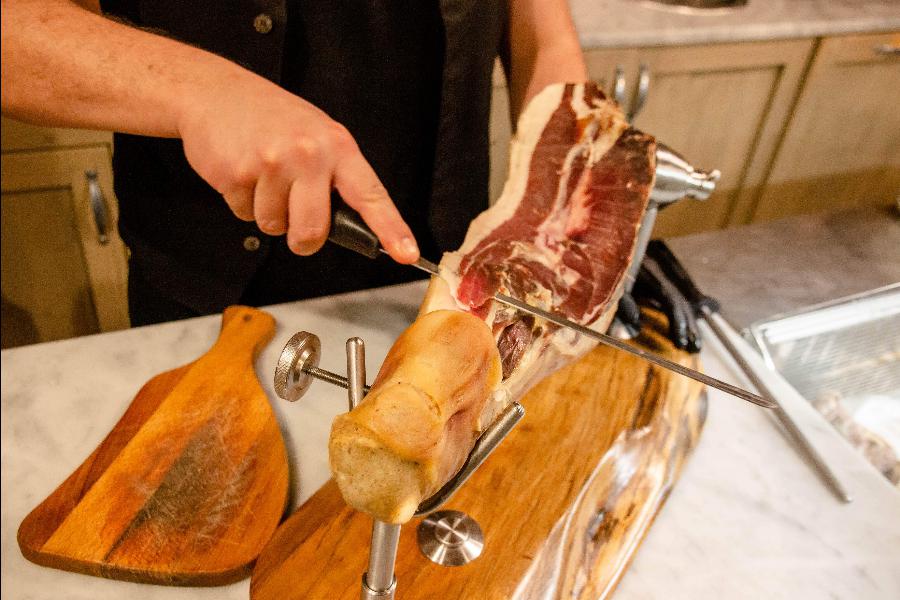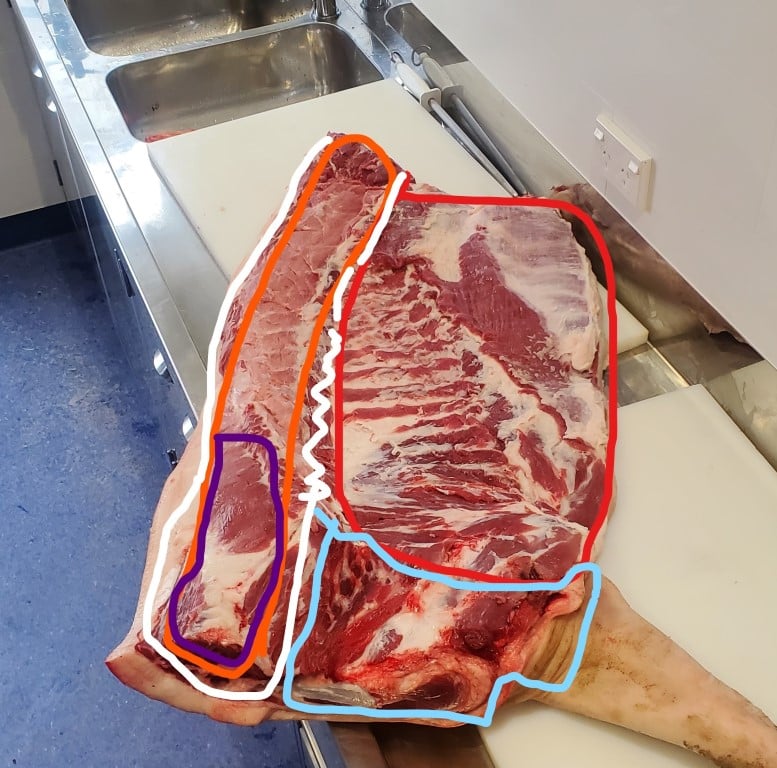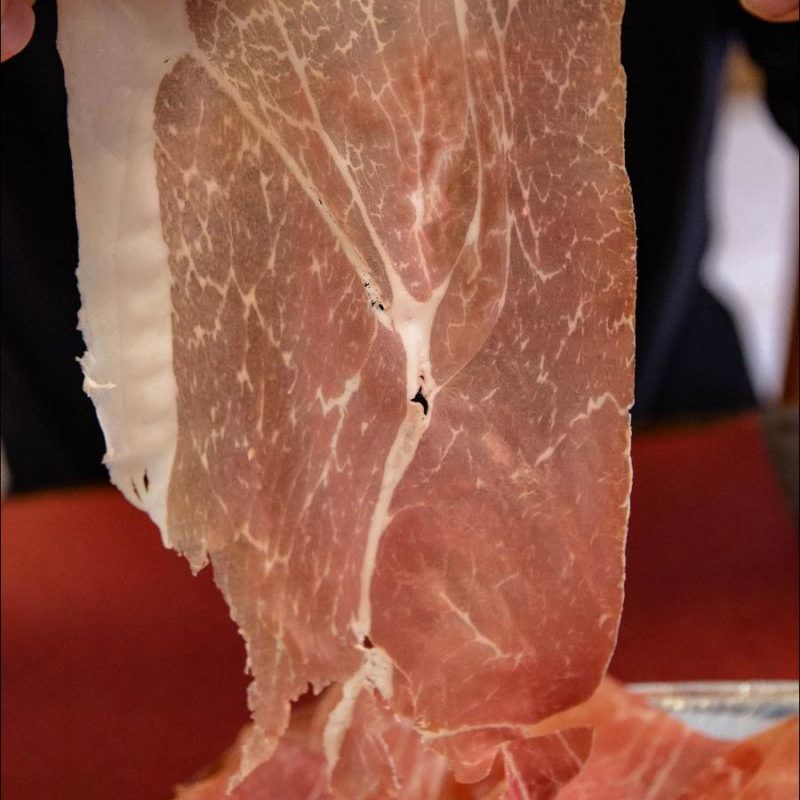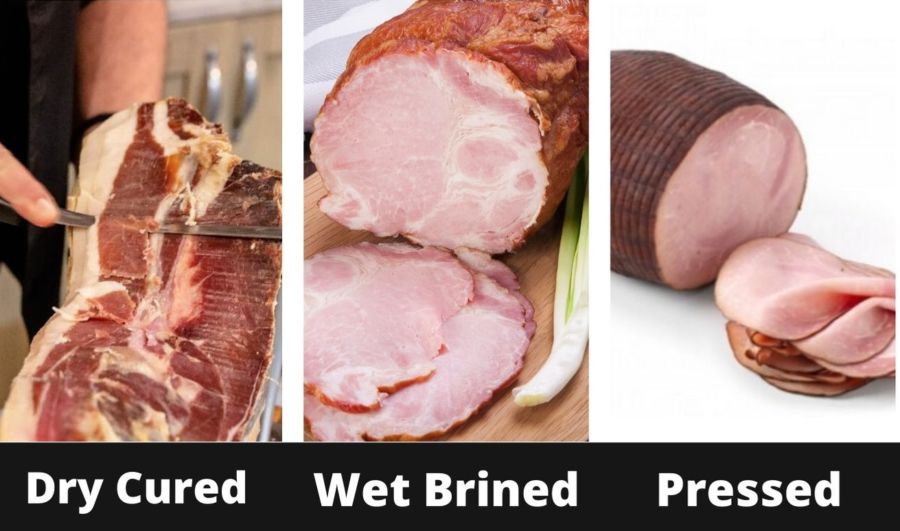Charcuterie meat comes in many different varieties, it’s a broad category and has various interpretations.
Generally speaking, charcuterie meats are dry-cured meats like prosciutto; however, there are other types, and pork is one of the meats used.
For most of the Italian and French styles of charcuterie, pork is a very important meat in the ingredients list.
Even though it is one of the main types of ingredients and meats used, there are now many other options I’ll mention below.
Many of my dry-cured meat projects have used wild venison. Below, I’ll make a list of pork-based charcuterie meats and discuss what part of the animal they derive from.
Pork is definitely the most used, so let’s get into what pork cuts make different cured meat charcuterie also.
What Charcuterie Meats are Pork
Pork is used for most charcuterie dry cured meats, this includes whole muscle cured meats and dry cured salami charcuterie. Most charcuterie meats need the neutral fat in pork.
The obvious pork charcuterie is prosciutto and pancetta in my opinion. Although, this is only the beginning.
Out of all the animal fats available from farmed or wild animals, the domesticated pig has a very neutral flavor. The fat is often in abundance on the pig and has a high melting point.
What I’ve learned is this translates when making cured meats in a way that benefits the overall finished product. The neutral fat does not develop a overly strong flavor after many months of drying which most charcuterie meats require.
Not all pork charcuterie meats are done on the way of prosciutto, I’ll cover these below too.
Solid pork back fat has less moisture content, so when I dry cure charcuterie meat I (we) don’t lose as much weight , since the process includes losing at least 30% of it’s original weight.
I thought it was useful to mention this, since the reason pork is used for many charcuterie meats is because of the fat.
For mouth feel, of course, as well.
When dry curing pork salami with atleaset 35% plus weight loss that occurs with dry cured salami, you always need 20 to 30% pork fat in the recipe.
Many commercial-made supermarket sali I’ve encountered in the Western World don’t dry out the salami. Due to commercial motivation, they are pumped with acidic preservatives, which creates a product that takes days, not months, to make.
(in my opinion this is not salami, it’s a sausage with preservatives)
It is true that most classic Italian charcuterie cured meats (not all have nitrates either – I wrote about that here), known as salumi are pork. Apart from braesola which is beef.

List of Charcuterie Meats That are Pork
The classic Italian (salumi) charcuterie cured meats from front to back of the pig.
| Pork Muscle | Part of Pig |
|---|---|
| Guanciale | Jowl |
| Coppa, Coppicolla | Upper Loin |
| Lonza, Lomo, Lonzino | Loin |
| Spalla | Front Leg |
| Pancetta | Pork Belly |
| Culatello | Deboned Hind Leg |
| Prosciutto | Hind Leg |

As part of salumi, there is the incredibly large category of salamis. Most of the charcuterie salami (salami is definitely part of it, I wrote a little more on that here) you will come across will be made of pork.
This would mainly be for dry cured salami that takes months to make (not weeks often the cheap ‘salami’ has a blend of offcut meats).
Italins include emulsified sausage style salami such as Mortadella, which has been bastardized into baloney in America as well.
Now if we take the classical French definition of charcuterie, and talk about the pork other variations are made into charcuterie, more on this later on.
Most Common Charcuterie Meat Containing Pork

In the many Western countries I’ve been to, these are the most common deli dry cured pork charcuterie meats.
Since these have are salt cured and dried – they are preserved and have a long shelf life when kept whole or in vac packed sliced packaging.
Prosciutto
Traditional Italian prosciutto takes a minimum of 12 months before it is ready, some types of prosciutto or Jamon from Spain are hung and dried up to five years!
Although I have seen smaller hindlegs of pork prosciutto that have been dried for only six months.
Italy has strict rules around what can be labeled prosciutto, I’ve seen in other countries, even on the other side of the world different drying times and technique (4 kg/8lb vs 11kg/22lb pork hind leg will take many months more to dry!)
Prosciutto is able to be dried without any caing, because the skin of the take prevents the drying from happening too fast. Whilst, the fat under the skin I believe also helps the long term drying.
Pork Dry Cured Salami
- Picante
- Soppressata
- Felino
- Genoa
Pancetta
One of the most classic pork cured meats that you can put on a charcuterie board is pancetta.
Salt cured and dried, pancetta is served wafer thin (here is something I wrote about epic charcuterie dry cured meats) and literally melts in your mouth.
If you buy pancetta of this type, you can wraparound all over other foods vegetables or lean meats to give it a flavor boost. ie. roasted asparagus, mushrooms etc..
Whole chunks of pancetta or gianciale are the secret to any good spaghetti carbonara pasta.
Un-common List of Charcuterie Meats Containing Pork
The classic French charcuterie meats are not the ones that are commonly found. These below are very classical French charcuterie made of pork.
This is what you would find on a French charcuterie board with pork being the meat.
- Saucisson sec Salami (popular in France, not common outside of France)
- Jambon Supérieur/Sec/Cru (French dry-cured hind leg, French version of Prosciutto)
- Jambon de Bayonne (another type of dry-cured prosciutto style with 700 years of history)
- Jambon de Paris / Paris Ham (wet cured cooked ham)
Classic Charcuterie Meats for a Charcuterie Board
The French definition of charcuterie in the classical sense, include the rillettes, terrines and different styles of ham.
Categories of Charcuterie Meat Containing Pork
- Rillettes & Terrines
- Salami
- Whole Muscle Dry Cured Meat
- Hot Smoked Sausage including Mortadella
- Hot Smoked & Cooked Hams
Rilettes & Terrines
Rillettes are commonly pork meat that has been preserved in a jar with pork or duck fat. A rich type of charcuterie, French classic. Often spread onto a slice of baguette or another type of bread.
Terrines are a type of jellied or gelatine set meat – sliced, often with pork but also with other meats as well.
Salami
The most common meat is pork used in most salamis of come across around the world. Pork fat is the most common salami fat, as I mentioned its due to the neutral flavor that pork fat has.
Whole Muscle Dry Cured Meat
The main types of whole muscle cured pork charcuterie I put in the table above. What you’ll find is most countries in Europe have variation of cured whole muscle charcuterie.
Prosciutto, Jamon or in Slovenia or Montenegro (they cold smoke it for 50 days!).
You’ll find beef, lamb, goat, duck and venison in various types of whole muscle cured charcuterie meat as well.
I am discovering new ideas and flavors especially more so in a place like America, where new tradition is always being formulated in some way. Lets see if these variations last the test of time like 700-year-old Paris ham or 2000-year-old prosciutto from Italy we shall see!
Hot Smoked Sausage Salami including Mortadella
Having made hot smoked sausage type (here are cooked/uncooked types I wrote about) salami, this can be achieved by cooking at a low temperature so that the pork fat does not render inside the sausage salami whilst it’s been cooked to a finished internal temperature.
And another version of this would be mortadella, or a more commercialized version – baloney.
If you either grind meat very finely or and cold water and ice you can extract protein called myosin from the meat. This creates the uniform texture that is familiar with these types of products.
Classic Italian mortadella which is pork and beef ground very finely has showcase pork fat inside of this type of charcuterie meat. It’s simmered/cooked very carefully so the showcase pork fat doesn’t render.
Hot Smoked & Cooked Hams
Hot smoked or cooked hams such as Paris ham in France or country ham and America.
Champagne ham is another version of this as well.
In many Western cultures, smoked Christmas ham falls into this category.

Hope you enjoy this little insight into Pork, Charcuterie and Curing Meat!

Tom Mueller
For decades, immersed in studying, working, learning, and teaching the craft of meat curing, sharing the passion and showcasing the world of charcuterie and smoked meat. Read More
